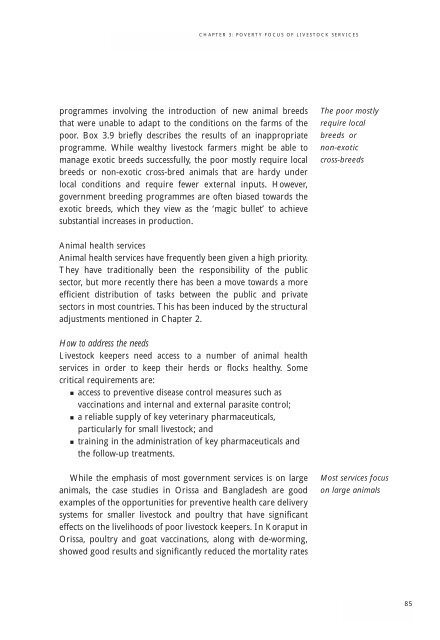Livestock Services and the Poor: A global initiative - IFAD
Livestock Services and the Poor: A global initiative - IFAD
Livestock Services and the Poor: A global initiative - IFAD
Create successful ePaper yourself
Turn your PDF publications into a flip-book with our unique Google optimized e-Paper software.
CHAPTER 3: POVERTY FOCUS OF LIVESTOCK SERVICES<br />
programmes involving <strong>the</strong> introduction of new animal breeds<br />
that were unable to adapt to <strong>the</strong> conditions on <strong>the</strong> farms of <strong>the</strong><br />
poor. Box 3.9 briefly describes <strong>the</strong> results of an inappropriate<br />
programme. While wealthy livestock farmers might be able to<br />
manage exotic breeds successfully, <strong>the</strong> poor mostly require local<br />
breeds or non-exotic cross-bred animals that are hardy under<br />
local conditions <strong>and</strong> require fewer external inputs. However,<br />
government breeding programmes are often biased towards <strong>the</strong><br />
exotic breeds, which <strong>the</strong>y view as <strong>the</strong> ‘magic bullet’ to achieve<br />
substantial increases in production.<br />
Animal health services<br />
Animal health services have frequently been given a high priority.<br />
They have traditionally been <strong>the</strong> responsibility of <strong>the</strong> public<br />
sector, but more recently <strong>the</strong>re has been a move towards a more<br />
efficient distribution of tasks between <strong>the</strong> public <strong>and</strong> private<br />
sectors in most countries. This has been induced by <strong>the</strong> structural<br />
adjustments mentioned in Chapter 2.<br />
How to address <strong>the</strong> needs<br />
<strong>Livestock</strong> keepers need access to a number of animal health<br />
services in order to keep <strong>the</strong>ir herds or flocks healthy. Some<br />
critical requirements are:<br />
access to preventive disease control measures such as<br />
vaccinations <strong>and</strong> internal <strong>and</strong> external parasite control;<br />
a reliable supply of key veterinary pharmaceuticals,<br />
particularly for small livestock; <strong>and</strong><br />
training in <strong>the</strong> administration of key pharmaceuticals <strong>and</strong><br />
<strong>the</strong> follow-up treatments.<br />
While <strong>the</strong> emphasis of most government services is on large<br />
animals, <strong>the</strong> case studies in Orissa <strong>and</strong> Bangladesh are good<br />
examples of <strong>the</strong> opportunities for preventive health care delivery<br />
systems for smaller livestock <strong>and</strong> poultry that have significant<br />
effects on <strong>the</strong> livelihoods of poor livestock keepers. In Koraput in<br />
Orissa, poultry <strong>and</strong> goat vaccinations, along with de-worming,<br />
showed good results <strong>and</strong> significantly reduced <strong>the</strong> mortality rates<br />
The poor mostly<br />
require local<br />
breeds or<br />
non-exotic<br />
cross-breeds<br />
Most services focus<br />
on large animals<br />
85

















